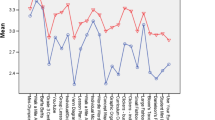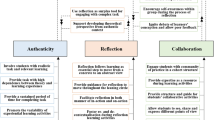Abstract
The science and technology education literature indicates that teaching within a constructivist paradigm is an effective way to promote student learning. Despite this, most primary school teachers do not use constructivist theoretical approaches because they are perceived as difficult and impractical to implement. To promote constructivist teaching and learning approaches in schools, teachers need access to models and strategies they can implement effectively and with relative ease. A unit of work was developed, based on the Five Es model (Engagement, Exploration, Explanation, Elaboration and Evaluation), and taught to a year 3 class. Ten students were participants in the study and became the sample. Data were analysed using two different methods to compare and validate findings. The unit of work, based on the Five Es model, was found to be interesting and fun by students, and motivated student learning and promoted student higher-order thinking.
Similar content being viewed by others
References
Aubusson, P., Watson, K., & Brown, G. (1998). Enhancing lower secondary science. Penrith, NSW: UniversityWestern Sydney.
Barry, K., & King, L. (1993). Beginning teaching. Sydney: Social Science Press.
Bell, B. (1993). Children's science, constructivism and learning in science. Geelong, Victoria: Deakin University Press.
Board of Studies. (1993). Science and Technology K-6 Syllabus and support document. North Sydney, NSW: Author.
Boud, D., & Miller, N. (Eds.). (1996). Work with experience. London: Routledge.
Baird, J. C., & Northfield, J. R. (Eds.). (1992). Learning from the PEEL experience. Melbourne, Victoria: Monash University.
Brooks, J. G. (1990). Teachers and students: Constructivist forging new connections. Educational Leadership, 47(5), 68–7.
Bybee, R. W., & Powell, J. C. (1993). Investigating diversity and limits, middle school science and technology. Dubuque, IA: Kendall Publishing.
Bybee, R. W. (1997). Achieving scientific literacy: From purposes to practices. Portsmouth, UK: Heinemann.
Driver, R. (1983). The pupil as scientist? London: Open University Press.
Driver, R., Asoko, H., Leach, J., Mortimer, E., & Scott, P. (1994). Constructing scientific knowledge in the classroom. Educational Researcher, 23, 5–12.
Elliot, S. N., Kratochwill, T. R., Littlefield, J., & Travers, J. F. (1996). Educational psychology: Effective teaching, effective learning. Dubuque, IA: Brown and Benchmark Publishers.
Galloway, D., Rogers, C., Armstrong, D., & Leo, E. (1998). Motivating the difficulty to teach. London: Longman.
Heiman, M., & Slomianko, J. (Eds.). (1987). Thinking skills instruction: Concepts and techniques. Washington, DC: National Education Association.
Henry, M., Knight, J., Lingard, R., & Taylor, S. (1988). Understanding schooling: An introductory sociology of Australian education. London: Routledge.
Karlsson, M. R. (1996). Motivating at-risk students. Westminster, CA: Teacher Created Materials.
Loughran, J., Mitchell, I., & Mitchell, J. (2002). Learning from teacher research. Crows Nest, Australia: Allen & Unwin.
Marton, F. (1988). Phenomenography:A research approach to investigating different understandings of reality. In R. B. Sherman & R. B. Webb (Eds.), Qualitative research in education: Focus and methods (pp. 567–568). London: Falmer.
Matthews, M. R. (Ed.). (1994). Science teaching, the role of history and philosophy of science. London: Routledge.
NSW Department of Education and Training (2000). 2000 Basic skills test results. Sydney: Author.
Osborne, R., & Freyberg, P. (1985). Learning in science. Auckland, NZ: Heinemann.
O'Tuel, F. S., & Bullard, R. K. (1995). Developing higher order thinking in the content area K-12. Pacific Grove, CA: Critical Thinking Press.
Prosser, M. (1993). Phenomenography and the principles and practices of learning. Higher Education, Research and Development, 12(1), 21–31.
Richardson, V. (Ed.). (1997). Constructivist teacher education. New York: Falmer.
Ritchie, S. M. (1998). The teacher's role in the transformation of students' understanding. Research in Science Education, 28(2), 169–185.
Skamp, K. (Ed.). (1998). Teaching primary science constructively. Sydney: Harcourt Publishers.
Swanage, M., & Lane, N. (1999). Primary investigations. Retrieved April 1999 from www.science.org.au/pi/intro.htm.
Tobin, K., & Tippins, D. (1993). Constructivism as a referent for teaching. In K. Tobin (Ed.), The practice of constructivism in science education (pp. 3–22). Hillsdale, NJ: Lawrence Erlbaum.
Wilks, S. (1995). Critical and creative thinking: Strategies for classroom inquiry. Armidale, NSW: Eleanor Curtain Publishing.
Author information
Authors and Affiliations
Rights and permissions
About this article
Cite this article
Boddy, N., Watson, K. & Aubusson, P. A Trial of the Five Es: A Referent Model for Constructivist Teaching and Learning. Research in Science Education 33, 27–42 (2003). https://doi.org/10.1023/A:1023606425452
Issue Date:
DOI: https://doi.org/10.1023/A:1023606425452




